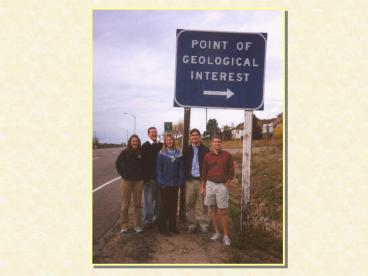MINERALS PowerPoint PPT Presentation
Title: MINERALS
1
(No Transcript)
2
(No Transcript)
3
MINERALS
TYPES OF BONDING
INTERMOLECULAR BONDING
HYDROGEN BONDING Occurs primarily between water
molecules due to polarity. VAN DER WAALS
BONDING Occurs when all electrons end up on one
side of atoms and a charge develops. Carbon
in Graphite
4
MINERALS
DETERMINANTS IN MINERAL FORMATION
The minerals that form in the Earth are dependent
upon abundance of available elements at time
of formation. size of the elements. temperatu
re and pressure at time of formation.
5
Most Abundant Elements in Earths Continental
Crust
ELEMENT PROPORTION OF CRUSTS WEIGHT () Oxygen
(O) 45.20 Silicon (Si) 27.20 Aluminum
(Al) 8.00 Iron (Fe) 5.80 Calcium
(Ca) 5.06 Magnesium (Mg) 2.77 Sodium
(Na) 2.32 Potassium (K)
1.68 98.03 All Other Elements
1.97 Total 100
Most minerals in Crust are oxygen-silicon based
compounds.
6
Most Abundant Elements in Entire Earth
ELEMENT PROPORTION OF EARTHS WEIGHT () Iron
(Fe) 34.80 Oxygen (O) 29.30 Silicon
(Si) 14.70 Magnesium (Mg) 11.30 Sulfur
(S) 3.30 Nickel (Ni) 2.40 Calcium
(Ca) 1.40 Aluminum (Al)
1.40 98.40 All Other Elements
1.60 Total 100
Most minerals in Upper Mantle are
oxygen-silicon-magnesium- iron compounds.
7
MINERALS
Size of elements is also a factor in mineral
formation. Positive ions are usually smaller
than negative ions. Smaller positive ions tend
to fit in spaces between larger negative ions.
8
MINERALS
COMMON MINERAL GROUPS
Rock forming minerals compose the most common
rocks in the Earths crust and mantle. Seven
basic mineral groups. Most of the minerals in
the crust and mantle are silicates.
9
MINERALS
NONSILICATE MINERALS NATIVE ELEMENTS
Elements are generally solitary (homogeneous). Do
not combine with other elements in nature. Gold
(Au) Silver (Ag) Platinum (Pt) Diamond
(C) Graphite (C) Sulfur (S) Copper (Cu)
Gold
Copper
Silver
10
MINERALS
NONSILICATE MINERALS CARBONATES
Carbonate ion (CO32-) is prominent in
minerals. Has -2 charge. Combines readily with
positive ions. Bonds generally weak. Minerals are
soft (3-4). Minerals are soluble in acidic
water. Leads to cave development. Calcite
(CaCO3) Dolomite (CaMg(CO3)2)
CALCITE
DOLOMITE
11
MINERALS
NONSILICATE MINERALS OXIDES
CORUNDUM
Produced when negative OXYGEN (O2-) ions combine
with positive metallic ions. Specular hematite
(Fe2O3) Oolitic hematite (Fe2O3) Magnetite
(Fe3O4) Corundum (Al2O3)
SPECULAR HEMATITE
OOLITIC HEMATITE
MAGNETITE
12
MINERALS
NONSILICATE MINERALS HYDROXIDES
Produced when negative HYDROXIDE (OH-) ions
combine with positive metallic ions. Limonite
(FeOOH) Bauxite
LIMONITE
BAUXITE
13
MINERALS
NONSILICATE MINERALS SULFIDES
Produced when negative SULFUR (S2-) ions combine
with positive metallic ions. Oxygens ugly
sibling. Pyrite (FeS2) Chalcopyrite
(Cu,FeS2) Galena (PbS) Sphalerite (Zn,Fe)S
PYRITE
GALENA
CHALCOPYRITE
SPHALERITE
14
MINERALS
NONSILICATE MINERALS SULFATES
Produced when negative SULFATE (SO42-) ions
combine with positive metallic ions. Gypsum
(CaSO4 . H2O)
15
MINERALS
NONSILICATE MINERALS HALIDES
Produced when negative HALIDE (F, Cl, Br, I) ions
combine with positive metallic ions. Halite
(NaCl) Fluorite (CaF2)
HALITE
FLUORITE
16
MINERALS
SILICATES AND THEIR STRUCTURE
Silicate minerals Constitute 90 of the weight
of the crust. Are a dominant constituent in
igneous, metamorphic, and sedimentary rocks.
Silicate crystal structure is a
repeated grouping of four oxygen ions and one
silicon ion. SiO4 Produces a silicon-oxygen
TETRAHEDRON.
17
MINERALS
SILICATES AND THEIR STRUCTURE
Silicon tetrahedron (SiO4) produced a -4
charge. Allows bonding with other elements or
other tetrahedra. Silicon-Oxygen Ratio Number
of O ions shared by tetrahedra. A tetrahedron
that shares none of its oxygen has SiO ratio
of 1-4. A tetrahedron that shares all of its
oxygen has SiO ratio of 1-2.
18
MINERALS
FIVE PRINCIPLE SILICATE STRUCTURES
1. INDEPENDENT TETRAHEDRA - ISLAND SILICATES
Independent tetrahedra have -4 charge. Tetrahedra
bond with positive ions. Share no oxygen
ions. Generally are hard minerals. Strong ionic
bonding exists. SiO ratio 14
OLIVINE
OLIVINE
STAUROLITE
GARNET
19
MINERALS
2. SINGLE CHAIN SILICATES
Silica tetrahedra share two corner oxygen
ions. Bonds with positive ions. Bonds within
chains are strong. Bonds between chains are
weak. Minerals cleave parallel to chains. SiO
ratio 13
AUGITE
Acquires Ca2, Mg2, Fe2 to neutralize ionic
charges.
20
MINERALS
3. DOUBLE CHAIN SILICATES
Tetrahedra share two corners in linear chain and
some share a third oxygen with tetrahedra in
neighboring chain. Shared oxygen ions bond chains
together. SiO ratio 12.75 Generally accept
Na, Ca2, Mg2, Fe2, Al3.
ACTINOLITE
HORNBLENDE
21
MINERALS
4. SHEET SILICATES
Tetrahedra share 3 basal oxygen ions. Produces a
sheet. Fourth oxygen bonds with positive
ions. This bonds the sheet together. Bonds
between the sheets are extremely weak. SiO ratio
12.5
MUSCOVITE
BIOTITE
22
MINERALS
5. FRAMEWORK SILICATES
Tetrahedra share all four oxygen ions with
adjacent tetrahedra. Produces three-dimensional
framework. SiO ratio 12 Quartz and relatives
and Feldspars two most abundant mineral groups
in the Earths crust.
23
FELDSPAR
Two groups Plagioclase feldspar contains Na and
Ca Orthoclase feldspar contains K All have 2
directions of cleavage at 90?. Most common
mineral group in Earths crust
QUARTZ (SiO2)
Has extremely strong bonds Hardest of the common
rock-forming minerals Has no cleavage, conchoidal
fracture Quartz and relatives second most
abundant mineral group in Earths crust.

